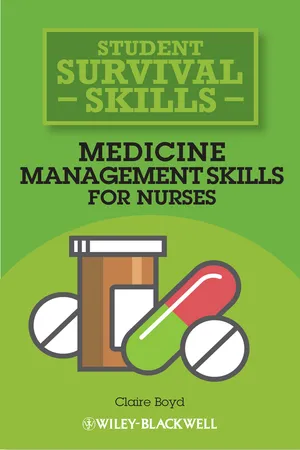
- English
- ePUB (mobile friendly)
- Available on iOS & Android
Medicine Management Skills for Nurses
About This Book
Anxious about managing medicines? Worried you'll make a mistake? This handy book is an essential guide for all nursing students, enabling you to understand the theory and practice of drug administration and facilitate your confidence and competence.
This essential guide explores the theory and practice of drug administration briefly and coherently, with 'test your knowledge' exercises and questions throughout to assess your learning. It also includes 'words of wisdom'- tips from real life students from their own experiences. Ideal for carrying to clinical placements, Medicine Management Skills for Nurses isanessential guide to drugs and medicine administration.
Special features:
- Pocket sized for portability
- Clear, straightforward, and jargon-free
- Takes away the fear of drugs and medicines management, making it approachable, easy and fun
- Features tips and advice from real life nursing students
- Ties in with the NMC standards for pre-registration education and the Essential Skills Clusters
- Examples and questions based on real life nursingand healthcare examples
Frequently asked questions
Information
Chapter 1
DRUG ADMINISTRATION: GENERAL PRINCIPLES
PROFESSIONALISM

Professionalism in nursing
TIME-AND-MOTION STUDIES

Question 1.1 How much time do you think nurses spend during a shift dispensing and administering drugs?
- documentation, 35.3%;
- medication administration, 17.2%;
- care co-ordination (handovers, etc.), 20.6%;
- patient care activities, 19.3%;
- patient assessment (observations), 7.2%.
LATIN ABBREVIATIONS

Activity 1.1
| STAT | OM | QDS |
| AC | ON | QQH |
| BD | PC | TDS |
| OD | PRN | TID |

We tend to use specific accepted abbreviations in health care to do with medicines, such as mg, PRN, IV, etc., but not mcg as we write micrograms in full so as not to get confused with mg. Healthcare workers are told not to use abbreviations in their written care plans, medical records, etc., as mistakes can happen. Terms may have two meanings: for instance, DOA can be taken to mean dead on arrival or date of admission.
DRUG WASTAGE
PROFESSIONAL JUDGEMENT
- It is not solely a mechanistic task to be performed in strict compliance with the written prescription of a medical practitioner.
- It requires thought and the exercise of professional judgement (Dougherty and Lister, 2011).

Question 1.2 If a patient has senna and lactulose prescribed and informs you that they have opened their bowels four times that day, do you administer their prescribed laxatives?
MEDICATION PROCESS
- Prescribing: it is often the nurse who notices that a doctor has prescribed something to which the patient is allergic, perhaps because the nurse knows the patient better.
- Dispensing and preparation: a nurse should not use trade names for drugs as confusion may occur, for example Voltarol instead of diclofenac sodium. Perhaps the pharmacist has reconstituted the medication with the wrong transport medium, for example sodium chloride instead of water for injection.
- Administration: you need to be very clear which route a medication should be given through and that the dose has been calculated correctly.
- Monitoring: you need to check the administrat...
Table of contents
- Cover
- Half Title page
- Title page
- Copyright page
- Preface
- Introduction
- Acknowledgements
- The 24-Hour Clock
- Chapter 1: Drug Administration: General Principles
- Chapter 2: Pharmacokinetics and Pharmacodynamics
- Chapter 3: Drugs and Medicines
- Chapter 4: Oral Drug Administration
- Chapter 5: Administration of Injections
- Chapter 6: Calculations for Working Out Dosages
- Chapter 7: Administration of Rectal and Vaginal Preparations
- Chapter 8: Administration of Topical Preparations
- Chapter 9: Administration of Inhalation Medications and Nebulisers
- Chapter 10: Administration of Intravenous Fluids
- Chapter 11: Administration of Intravenous Bolus Medications
- Chapter 12: Administration of Continuous Intravenous Infusions
- Chapter 13: Administration Via Percutaneous Endoscopic Gastrostomy, Percutaneous Endoscopic Jejunostomy or Nasogastric Tube
- Chapter 14: Drugs and Specific Medical Conditions
- Chapter 15: Pain Management
- Chapter 16: Knowledge Test
- Answers to Activities, Questions and “Test Your Knowledge”
- Appendix 1: Specific Competencies: Medicines Management
- Appendix 2: A Typical Prescription Chart
- Bibliography
- Index